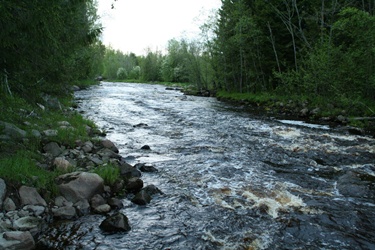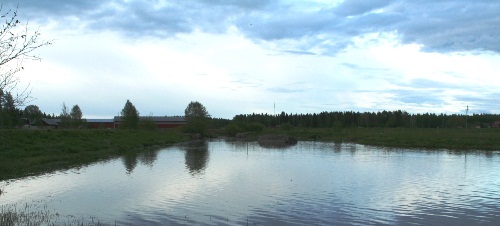Vääräjoki - Niskakoski
Vääräjoki - Niskakoski
Key features of the case study
Vääräjoki is a mid-sized lowland river with 835 km2 catchment area. The river is altogether 107 km long and descends 110 metres from its source to the confluence of the rivers Vääräjoki and Kalajoki.
Water quality of Vääräjoki is deteriorated due to human activities in the catchment. 12 % of the catchment area is in agricultural use. Also forestry activities, such as land draining by ditches, increase the nutrient load and suspended solids.
Site description
Drivers, Pressures, Measures
Altogether 25 km of Vääräjoki were channelized for flood protection and timber floating starting in 1860s and continuing in several occasions until late 1950s. In 1959-1974 lake Evijärvi at mid reach of Vääräjoki was dried for flood protection. Altogether 900 ha of lake area was dried by channelizing the river and by embankments. Especially the activities for flood protection changed the riffle areas considerably: the water retention capacity of the river bed decreased and the heterogeneous flow patterns in riffle habitats disappeared.
All the rapids in section from 13 km to 29 km of the river mouth have been restored. The extensive works started in the late 1990s and finished in 2006. The stream bottom was rearranged using boulders that had originally been removed from the channel during channelization and placed along stream margins Also gravel beds were created to provide nursery habitat for salmonids. The aim of the restoration was to return the heavily modified river closer to natural hydrological and morphological state and especially enable the breeding and migration of fish. Funding for restoration came from regional water and fisheries boards.
At the time of writing in Autumn 2013, there are plans to continue the restoration works at the other reaches: the restoration plan for upstream reach 35-86 km from river mouth is ready and the restoration work is about to begin. The plan to restore the downstream part of the river (0-13 km from the river mouth) is about to be ready.
The riffles in upper part of the river and downstream reaches of the river are yet not restored. Vääräjoki was chosen as a REFORM WP4 “flagship” case study river due to the extensive restorations and because it is among the few rivers in Finland that still had non-restored upstream control sites to meet the study design of WP4. Peurasaarenkoski is one of the channelized riffle sites and it is the non-restored control site in WP4 case study. Niskakoski is one of the restored riffle sections and it is the restored site in WP4 case study (Picture 1).
 Picture 1: Niskakoski, a restored site at river Vääräjoki.
Picture 1: Niskakoski, a restored site at river Vääräjoki.
Picture 2. Vääräjoki: lowland river with agriculture in the catchment area.
Measures selection
No information found.
Success criteria
No information found.
Ecological response
Periphyton showed good quality in 2003. In 2009 and 2012 11 fish sites were monitored. The monitoring indicated good status of the fish communities and no change to the previous results (EQR = 0,65). The ecological status of Vääräjoki has been assessed as moderate in first and second national assessment for WFD.
Water quality response
The restorations have likely not affected the water quality, water quality has deteriorated from moderate (2000-2007) to poor (2006-2012) status.
Hydromorphological response
No information found.
Monitoring before and after implementation of the project
Before-after monitoring of the restoration success was not done. However, assessment of the ecological and water quality status of River Vääräjoki has been done after the restorations.
Socio-economic aspects
A socio-economic study was conducted at Vääräjoki area as a part of REFOM-project in April 2013. The study was carried out as a questionnaire at Vääräjoki basin. The questionnaire contained questions about residents’ general perception of the river, including water quality, floods and the restoration measures. The questionnaire contained also Choice Experiment in which respondents were presented Choice Cards with two or more alternative future states and an option to maintain the current situation. The alternatives described different end states created through river restoration measures (Figure 1). “Willingness to pay”-survey was represented by an increase of annual municipality tax for the respondent’s household. To find sufficient respondents in the sparsely populated Vääräjoki basin three different methods were used: approaching visitors at nearby village centers, “door to door” interviews and approaching pedestrians at more sparsely populated rural areas. In total 67 people were interviewed. 56 of the respondents were residents of the area, 7 were visitors of whom 2 had a summer cottage within the river corridor. A large majority of the local inhabitants visit the river at least several times a year (78% of the respondents). Around 22% of the respondents visit the river daily. The most common activities were bird or animal watching, angling and walking the dog along the river (Figure 2).
A slight majority of the respondents was aware of the restorations. Plans about expansion of the restorations to upstream sections of the river were less well known: around 30% of the respondents were aware of the plans. In the choice experiment most respondents were willing to have a tax increase in order to realize some restorations. From the chosen alternatives that included a raise of municipality tax 52% choose the alternative with the lowest cost. The average willingness to pay of the chosen alternatives was 29 euro.
In conclusion, the people at Vääräjoki area do visit the river often and appreciate it. They do not only appreciate the river for their own use, but also as a recreational area for other people to enjoy and as a habitat for organisms. Awareness about the river restorations is high and a large majority of the interviewed people perceives the restorations a good idea. Not everyone had a clear view on the effects of the restorations, but most consider improvements in ecological endpoints the main goal. The local people at Vääräjoki area are willing to pay for improved ecological conditions and a more natural view.
Contact person within the organization
Finnish Environmental Institute, Freshwater Centre
Jukka Aroviita
E-mail: jukka.aroviita@ymparisto.fi
Extra background information
Vääräjoki is part of Kalajoki basin, where are several ongoing projects targeting to improved status of inland waters at the area.
MAHAKALA-project
When sulfate soils, typical to Kalajoki area, are exposed to oxygen, during soil preparation, ditching or natural land uplift, they might be oxidized and produce acidic runoff. Acidic sulfate soil may cause acidification of waters which might lead to leaking of heavy metals into the waters. The aim of the MAHAKALA-project is study the effects and risks of the acidic soils to the environment and livelihoods. Project Website
Meidän Kalajoki (Our Kalajoki)-Project
Meidän Kalajoki -project is a co-operative initiative where local municipalities, officials, scientists, organizations and companies aim to contribute to the water protection in the Kalajoki basin, consult about the use of waters and find new ideas to improve the general appreciation of Kalajoki. The background of the project is the Water Framework Directive goals of good ecological status of waters but also the local aims to improve the scenery, conditions for fish and recreation of the Kalajoki basin. Project is funded by European Regional Development Fund. Project Website
References
Aluehallintovirato. Ympäristöluvat. Lupapäätös Nro 2/12/2. Vääräjoen kalataloudellinen kunnostus, Sievi.
-Aronsuu K. & Isid D. 2010. Pohjois-Pohjanmaan jokien hydrologis-morfologiset muutokset sekä mahdolliset hydrologiaan ja morfologiaan vaikuttavat toimenpiteet jokien ekologisen tilan parantamiseksi, www.ymparisto.fi/oulujoen-iijoenvesienhoitoalue
Plug M.C. Comparing the restored and unrestored an Ecosystem Service valuation of the Vääräjoki: A case study for the REFORM project. Amsterdam Free University. Master thesis (unpublished).
Restoration plan for Vääräjoki, unpublished.
Savolainen, M. ja Leiviskä, P. 2008. Kalajoen vesistön tulvantorjunnan toimintasuunnitelma. Pohjois-Pohjanmaan ympäristökeskuksen raportteja 2/2008.
The Finnish Environmental Information: Hertta database.
Vesien kunnostustyöryhmä. 2012. Vesien kunnostustyöryhmän loppuraportti. http://www.hare.vn.fi/mAsiakirjojenSelailu.asp?h_iId=16574&a_iId=180254
Related Measures
- Improve water retention
- Add/feed sediment
- Shallow water courses
- Add sediments
- Initiate natural channel dynamics to promote natural regeneration
- Reduce impact of dredging
- Recreate gravel bar and riffles
- Lower river banks or floodplains to enlarge inundation and flooding
- Other measures
